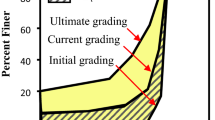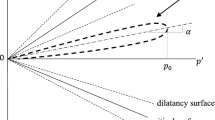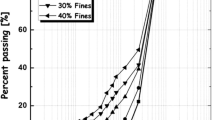Abstract
Depending on the characteristics of soil particles and external load, natural soils often undergo particle breakage which may significantly influence their mechanical behavior. In this study, a hypoplastic model is proposed to describe the sand behavior over a wide range of stress levels, especially those sufficient to cause particle breakage. The characterized void ratios and granulate hardness of the model are related to the plastic work to reflect the impact of particle breakage on the strength and deformation properties of sand. The influence of confining pressure on the extent of particle breakage is properly considered. The model is demonstrated to be capable of simulating the response of crushable sand under various test conditions. The simulation results of the original hypoplastic model are also presented, which indicates that neglecting the particle breakage may cause unreasonable predictions at high stress state.














Similar content being viewed by others
Data availability
The codes for implementing the hypoplastic model in this study are available upon reasonable request.
Abbreviations
- σ, ε :
-
Stress tensor and strain tensor
- \({\varvec{\mathcal{L}}}\), N :
-
Linear term and nonlinear term of the hypoplastic model
- p, p 0 :
-
Mean normal stress and its initial value
- p a :
-
Atmospheric pressure
- q :
-
Deviatoric stress
- η :
-
Stress ratio
- ε v, ε q :
-
Volumetric strain and deviatoric strain
- ε a :
-
Axial strain
- f s, f d :
-
Stiffness factor and barotropy factor
- h s , h s0 :
-
Granular hardness and its initial value
- φ c :
-
Critical friction angle
- B :
-
Hypoplastic flow direction
- \(W_{{\text{p}}}\), \(\dot{W}_{{\text{p}}}\) :
-
Plastic work and its rate
- e , e 0 :
-
Void ratio and its initial value
- e i, e d, e c :
-
Upper bound, lower bound, and critical state void ratios
- e i 0, e d0, e c0 :
-
Values of ei, ed, ec at p = 0 kPa
- \(\Delta e_{i0} , \, \Delta e_{d0} , \, \Delta e_{c0}\) :
-
Variations of ei0, ed0, ec0 Caused by the particle breakage
- e max, e min :
-
Maximum and minimum void ratios
- \(\varepsilon_{v}^{f}\) :
-
Volumetric strain at failure
- E 5% :
-
Ratio of deviatoric stress to axial strain at \(\varepsilon_{a}^{{}} = 5\%\)
References
Andria-Ntoanina I, Canou J, Dupla JC (2010) Caractérisation mécanique du sable de Fontainebleau NE34 à l’appareil triaxial sous cisaillement monotone. Laboratoire Navier. Géotechnique (CERMES, ENPC/LCPC)
Bandini V, Coop MR (2011) The influence of particle breakage on the location of the critical state line of sand. Soils Found 51(4):591–600
Bauer E (1996) Calibration of a comprehensive hypoplastic model for granular materials. Soils Found 36(1):13–26
Biarez J, Hicher PY (1994) Elementary mechanics of soil behaviour. Balkema, Rotterdam
Carrera A, Coop M, Lancellotta R (2011) Influence of grading on the mechanical behaviour of Stava tailings. Géotechnique 61(11):935–946
Donohue S, O’Sullivan C, Long M (2009) Particle breakage during cyclic triaxial loading of a carbonate sand. Géotechnique 59(5):477–482
Einav I (2007) Breakage mechanics—part i: theory. J Mech Phys Solids 55(6):1274–1297
Frossard E, Hu W, Dano C, Hicher PY (2012) Rockfill shear strength evaluation: a rational method based on size effects. Géotechnique 62(5):415–427
Fuentes W, Wichtmann T, Gil M, Lascarro C (2020) ISA-Hypoplasticity accounting for cyclic mobility effects for liquefaction analysis. Acta Geotech 15(6):1513–1531
Gao R, Ye JH (2023) Mechanical behaviors of coral sand and relationship between particle breakage and plastic work. Eng Geol 316:107063
He SH, Ding Z, Sun YF, Goudarzy M, Chen WY (2022) Stress–dilatancy behavior of dense marine calcareous sand under high-cycle loading: an experimental investigation. Ocean Eng 244(15):110437
He YQ, Liao HJ, Wu W, Wang S (2023) Hypoplastic modelling of inherent anisotropy in normally and overconsolidated clays. Acta Geotech. https://doi.org/10.1007/s11440-023-01923-3(012345678
Herle I, Gudehus G (1999) Determination of parameters of a hypoplastic constitutive model from properties of grain assemblies. Mech Cohesive Frict Mater 4(5):461–486
Ishihara K (1993) Liquefaction and flow failure during earthquakes. Géotechnique 43(3):351–451
Jerman J, Mašín D (2020) Hypoplastic and viscohypoplastic models for soft clays with strength anisotropy. Int J Numer Anal Meth Geomech 44(10):1396–1416
Jia YF, Xu B, Chi SC, Xiang B (2017) Research on the particle breakage of rockfill materials during triaxial tests. Int J Geomech 17(10):04017085
Kong XJ, J. Liu M, Zou DG, Liu HB (2016) Stress-dilatancy relationship of Zipingpu gravel under cyclic loading in triaxial stress states. Int J Geomech 16(4):04016001
Lade PV, Yamamuro JA, Bopp PA (1996) Significance of particle crushing in granular materials. J Geotech Eng 122(4):309–316
Lade PV, Yamamuro JA (2006) Undrained sand behavior in axisymmetric tests at high pressures. J Geotech Eng 122(2):120–129
Liao D, Yang ZX (2022) Hypoplastic model for sand under multidirectional shearing conditions considering fabric change effect. Soil Dyn Earthq Eng 155:107168
Liao D, Yang ZX (2020) Hypoplastic modeling of anisotropic sand behavior accounting for fabric evolution under monotonic and cyclic loading. Acta Geotech 16(7):2003–2029
Liao D, Yang ZX (2021) Non-coaxial hypoplastic model for sand with evolving fabric anisotropy including non-proportional loading. Int J Numer Anal Meth Geomech 45(16):2433–2463
Liao D, Yang ZX (2022) Hypoplastic modeling of anisotropic sand behavior accounting for rotation of principal stress direction. J Eng Mech 148(10):04022060
Liao D, Yang ZX, Wang S, Wu W (2022) Hypoplastic model with fabric change effect and semifluidized state for post-liquefaction behavior of sand. Int J Numer Anal Meth Geomech 46(10):3154–3177
Liao D, Yang ZX, Wang S, Wu W (2023) A hypoplastic model for cemented sand under monotonic and cyclic loading. Can Geotech J. https://doi.org/10.1139/cgj-2023-0079
Liu HB, Zou DG (2013) Associated generalized plasticity framework for modeling gravelly soils considering particle breakage. J Eng Mech 139(5):606–615
Luong M, Touati A (1983) Sols grenus sous fortes contraintes. Rev Fr Géotech 24:51–63
Miura N, Yamanouchi T (1973) Compressibility and drained shear characteristics of a sand under high confining pressures. Technol Rep Yamaguchi Univ 1(2):271–290
Murphy DJ (1987) Stress, degradation, and shear strength of granular material. Geotechnical modeling and applications. Gulf Publishing Company, Houston, pp 181–211
Muir Wood D, Maeda K (2008) Changing grading of soil: Effect on critical states. Acta Geotech 3(1):3–14
Nazanin I, Lashkari A, Tafili M, Wichtmann T (2022) A state-dependent hyperelastic-plastic constitutive model considering shear-induced particle breakage in granular soils. Acta Geotech 17(11):5275–5298
Nguyen GD, Einav I (2009) The energetics of cataclasis based on breakage mechanics. Pure Appl Geophys 166(10–11):1693–1724
Niemunis A, Herle I (1997) Hypoplastic model for cohesionless soils with elastic strain range. Mech Cohesive Frict Mater 2(4):279–299
Niemunis A (2003) Extended hypoplastic models for soils. Ruhr-University Bochum, Germany, Habilitation, Institute for foundation engineering and soil mechanics
Phuong NTV, Rohe A, Brinkgreve RBJ, van Tol AF (2018) Hypoplastic model for crushable sand. Soils Found 58(3):615–626
Qian HY, Wu W, Xu CS, Liao D, Du XL (2023) An extended hypoplastic constitutive model considering particle breakage for granular material. Comput Geotech 159:105503
Roscoe KH, Schofield AN (1963) Mechanical behaviour of an idealised ‘wet clay’. In: Proceedings of the 2nd European conference on soil mechanics and foundation engineering, Wiesbaden, Germany, pp 47–54
Roscoe K, Burland J (1968) On the generalized stress strain behaviour of ‘wet’ clay. In: Heyman J, Leckie F (eds) Engineering plasticity. Cambridge University Press, Cambridge, pp 535–608
Roscoe KH, Schofield AN, Wroth CP (1958) On the yielding of soils Géotechnique 8(1):22–53
Schofield AN, Wroth CP (1968) Critical state soil mechanics. McGraw-Hill, New York
Tafili M (2020) Triantafyllidis T (2020) AVISA: anisotropic visco-ISA model and its performance at cyclic loading. Acta Geotech 15(9):2395–2413
Tengattini A, Das A, Einav I (2016) A constitutive modelling framework predicting critical state in sand undergoing crushing and dilation. Géotechnique 66(9):695–710
Varadarajan A, Sharma KG, Venkatachalam K, Gupta AK (2003) Testing and modeling two rockfill materials. J Geotech Geoenviron Eng 129(3):206–218
Von Wolffersdorff PA (1996) A hypoplastic relation for granular materials with a predened limit state surface. Mech Cohesive-Frict Mater 1(3):251–271
Wang G, Wang ZN, Ye QG, Wei X (2020) Particle Breakage and deformation behavior of carbonate sand under drained and undrained triaxial compression. Int J Geomech 20(3):04020012
Wang S, Wu W, Zhang D, Kim JR (2020) Extension of a basic hypoplastic model for overconsolidated clays. Comput Geotech 123:103486
Wang S, Wu W (2021) A simple hypoplastic model for overconsolidated clays. Acta Geotech 16(1):21–29
Wang S, Wu W (2021) Validation of a simple model for overconsolidated clay. Acta Geotech 16(1):31–41
Wang S, Wu W, Yin ZY, Peng C, He X (2018) Modelling the time-dependent behaviour of granular material with hypoplasticity. Int J Numer Anal Methods Geomech 42:1331–1345
Wei HZ, Zhao T, He JQ, Meng QS (2018) Evolution of particle breakage for calcareous sands during ring shear tests. Int J Geomech 18(2):04017153
Wu W (1996) Niemunis A (1996) Failure criterion, flow rule and dissipation function derived from hypoplasticity. Mech Cohesive-Frict Mater 1:145–163
Wu W (1998) Rational approach to anisotropy of sand. Int J Numer Anal Methods Geomech 22(11):921–940
Wu W, Bauer E (1994) A simple hypoplastic constitutive model for sand. Int J Numer Anal Methods Geomech 18(12):833–862
Xiao Y, Meng MQ, Daouadji A, Chen Q, Wu Z, Jiang X (2020) Effects of particle size on crushing and deformation behaviors of rockfill materials. Geosci Front 11(2):375–388
Xiao Y, Liu HL, Ding XM, Chen XM, Jiang JS, Zhang WG (2016) Influence of particle breakage on critical state line of rockfill material. Int J Geomech 16(1):04015031
Xue Y, Miao FS, Wu YP, Daniel D (2022) Dynamic stability assessment of reservoir colluvial landslide using a hypoplastic clay constitutive model considering the effects of drying-wetting cycles on the hydro-fluctuation belt. Eng Geol 307:106791
Yamamuro JA, Bopp PA, Lade PV (1996) One-dimensional compression of sands at high pressures. J Geotech Eng 122(2):147–154
Yang J, Wei LM (2012) Collapse of loose sand with the addition of fines: The role of particle shape. Géotechnique 62(12):1111–1125
Yu FW (2017) Particle breakage and the drained shear behavior of sands. Int J Geomech 17(8):04017041
Yu FW (2017) Characteristics of particle breakage of sand in triaxial shear. Powder Technol 320:656–667
Acknowledgements
The authors are grateful to the Chongqing Natural Science Key Program (Grant Nos. cstc2020jcyj-zdxmX0019) and National Natural Science Foundation of China (Grant Nos. 42241109) for the financial support.
Author information
Authors and Affiliations
Corresponding author
Additional information
Publisher's Note
Springer Nature remains neutral with regard to jurisdictional claims in published maps and institutional affiliations.
Rights and permissions
Springer Nature or its licensor (e.g. a society or other partner) holds exclusive rights to this article under a publishing agreement with the author(s) or other rightsholder(s); author self-archiving of the accepted manuscript version of this article is solely governed by the terms of such publishing agreement and applicable law.
About this article
Cite this article
Liao, D., Wang, S. & Zhang, C. A hypoplastic model for crushable sand under a wide range of stress levels. Acta Geotech. (2024). https://doi.org/10.1007/s11440-024-02230-1
Received:
Accepted:
Published:
DOI: https://doi.org/10.1007/s11440-024-02230-1




